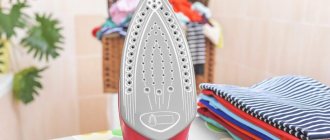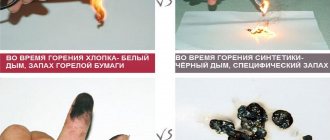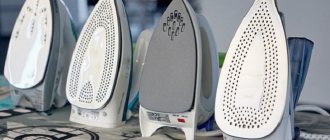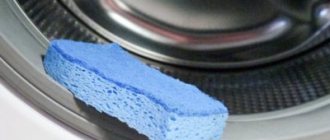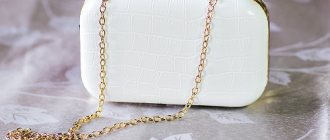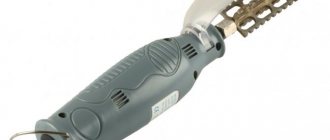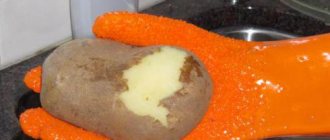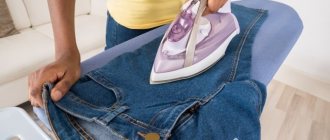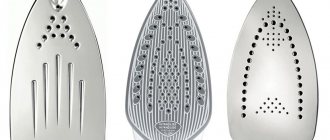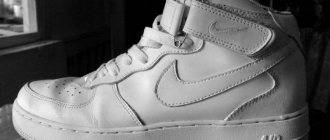4.8 / 5 ( 29 votes)
No matter how great the iron is, it still needs care, incl. in regular cleaning of the soles. This is where soot often forms. It can damage clothes and negatively affect the quality of the iron itself. But don’t panic and immediately think about buying a new device, because we’ll now tell you how to easily get rid of carbon deposits. We have prepared the best selection of recipes that will help you effectively clean the soleplate of your iron .
Outsole material
What types of iron soles are there?
First, let's talk about what material the sole of your iron can be made from. It depends on the material which recipes you can use to clean the soleplate of your iron at home. And which ones cannot be used, because... they may damage the device.
Manufacturers choose the following materials:
- Aluminum . Perhaps one of the most popular materials, because... it belongs to the budget category. Aluminum also conducts heat well, is lightweight, but cannot be said to be durable and reliable. For example, an aluminum sole can leave a hole in a T-shirt if the temperature is not adjusted correctly. And you can’t iron the wool at all.
- Stainless steel . The iron will cost more, but its quality will be better. The sole heats up evenly, which minimizes the possibility of damaging the fabric. Stainless steel is durable and resistant to rust and damage. Therefore, you can safely choose even rough cleaning of the iron to remove burnt marks on the sole.
- Ceramics . It glides easily, removes wrinkles well and heats up evenly. Also, threads and fibers do not collect on the sole, and there are no puffs left on clothes.
- Teflon . A good iron for delicate items. But you also need to handle it carefully, because... Scratches may appear on the surface, and Teflon itself wears off faster than other materials.
All the recipes that we will discuss below are suitable for cleaning the ceramic soleplate of an iron. But to clean the soleplate of a Teflon-coated iron, pay attention to only two methods:
- Pencil.
- Vinegar 70%.
Types of coatings
When choosing a product to remove burnt fabric, you need to consider the coating material. The following types of iron soles are widely available:
- stainless steel;
- aluminum;
- ceramic;
- Teflon.
The first two types of soles are metal. To rid the surface of burnt surfaces, cleaning agents with hard particles - abrasives - are used. Do not use acids and acetone, as these substances can react with metal.
Ceramic and Teflon soles require delicate handling. After cleaning with abrasives, scratches remain on the iron, attracting small fibers of the fabric. As a result, the device sticks to clothes and linen even more strongly than before. You can wipe off carbon deposits using a special pencil or liquid solutions.
Recipe 1: Clean the soleplate of the iron with salt
How to clean the soleplate of an iron with salt?
Ingredients:
- Salt.
- A blank sheet of paper or cardboard.
How to clean the soleplate of your iron with salt:
- Spread the salt in one layer on a clean sheet of paper or cardboard.
- Split the iron.
- Run the iron over the salt scattered on the sheet, pressing the soleplate firmly. The salt will remove all the carbon deposits from the surface.
Important! Please note that this recipe is not suitable if you need to clean the soleplate of a Teflon iron. Because Coarse salt can scratch it.
How to prevent scale formation
To avoid having to clean scale deposits later, monitor the quality of the liquid you pour into the container. Best for ironing with steam:
- Bottled water, which can be purchased at any grocery store.
- Distilled water. Can be purchased at any gas station.
- Water purified by a home household filter.
- Settled water from the tap. In just a few hours, the salts will precipitate.
Remember that timely prevention will extend the life of electrical appliances. Learn the principles of proper ironing, read the tags on clothes and never leave the appliance turned on unattended. If an emergency occurs, the simple and effective recipes suggested above will help you.
Recipe No. 2. How to clean the soleplate of an iron with vinegar?
How to clean the soleplate of an iron with vinegar?
In any home there is vinegar, which serves as an excellent cleanser, incl. will help you quickly clean the soleplate of your iron.
Ingredients:
- Vinegar.
- Cotton wool, cloth or towel.
- Water.
How to quickly clean the soleplate of your iron with vinegar:
- Option 1 . Soak cotton wool in vinegar and wipe the areas where the burnt marks appear. There is no need to turn on the iron.
- Option 2 . Soak a cloth in vinegar and place a warm, but not turned on, iron on it. Leave the device in this position for several hours. And then wipe dry with a clean cloth.
- Option 3 . Combine 2 tbsp. l. vinegar with a glass of water. Soak a towel in the solution and iron it with an iron operating at medium heat. The best option for large stains.
This recipe is suitable for cleaning the ceramic soleplate of an iron, as well as Teflon, if you use 70% vinegar.
Rules for cleaning Teflon-coated irons
Teflon is a slippery and durable material that is used in the production of ironing electrical appliances. If the operating rules are violated, synthetics may stick and burn to such a reliable sole. To solve this problem, you should study the rules:
- Cleaning products that contain abrasives are aggressive and can make the problem worse. It is not recommended to use them.
- It is forbidden to clean Teflon surfaces with metal sponges or sandpaper.
- Suitable materials for removing dirt are cotton swabs or pads. Manufacturers additionally offer Teflon scrapers to remove stains or carbon deposits.
- Strictly follow the cleaning instructions and do everything with the power off.
Recipe No. 3. How to clean the soleplate of an iron with soda?
How to clean the soleplate of an iron with soda?
Another remedy that you always have at home is baking soda. It will also cope with cleaning the soleplate of the iron from carbon deposits.
What to take:
- Baking soda (plus extra hydrogen peroxide).
- Water.
- Capacity.
How to clean the soleplate of an iron with soda:
- In a container convenient for you, combine baking soda and water, you should get a thick paste.
- Rub the mixture into the sole.
- Then rinse the solution with water and wipe clean.
Second way:
- Heat the iron to the highest possible temperature.
- Soak the sole with peroxide.
- Wait until it cools down.
- Apply a mixture of baking soda and water to the cold sole.
- Wait about 7 minutes. and rinse off the residue, and then wipe the surface with a clean cloth.
Important! We remember that soda is contraindicated for cleaning the soleplate of a Teflon-coated iron.
Salt
Using regular salt for cleaning is not the most effective, but it is a cheap and accessible method for everyone. The product can be poured onto cardboard or foil and distributed evenly. Then you should walk over the salt layer with the heated sole of the iron until the carbon deposits are completely removed.
The second use option involves wrapping salt (2-3 tbsp is enough) in cotton cloth. The bundle is used to rub the heated sole. Unlike the first method, this one is suitable not only for metal and ceramics, but also for Teflon coating.
Recipe No. 4. Cleaning the soleplate of the iron with laundry soap
How to clean the soleplate of an iron with laundry soap?
It will help if you decide to clean the ceramic sole of your iron at home, but the carbon deposits on it are not strong.
What to take:
- Laundry soap.
- Warm water.
- Capacity.
- A napkin or cotton swab, cotton swabs.
How to clean the soleplate of an iron with laundry soap:
- Preheat the iron at minimum temperature.
- Rub the surface with a bar of soap.
- Wait until the soap softens the carbon deposits.
- Remove soap residue with a napkin or disk, and treat the steam holes with a cotton swab.
Second way:
- Dissolve crushed pieces of soap in warm water.
- Use a napkin to wipe off the soot as much as possible.
- Apply a soap solution to a dry sole heated at a minimum temperature.
- Wait 20 min.
- Wipe the surface with a clean cloth.
Laundry soap
A bar of laundry soap will remove only fresh carbon deposits. Removing long-frozen dirt with its help will be ineffective. The method consists of performing the following steps:
- A small amount of crushed soap is dissolved in warm water (1 tbsp is enough).
- The surface of the sole is wiped with a cloth soaked in water and wiped dry.
- Apply dissolved soap to a slightly heated sole and leave for 15–20 minutes.
When the surface has cooled and the mixture has hardened, the laundry soap should be washed off with a damp sponge. Most of the carbon deposits will be removed along with the dried soap crust.
Recipe No. 5. How to clean the soleplate of an iron with toothpaste?
How to clean the soleplate of an iron with toothpaste?
Cleaning the soleplate of your iron with toothpaste is very easy.
What to take:
- I love any toothpaste.
- Brush or soft cloth.
- A napkin.
How to clean the soleplate of your iron with toothpaste:
- Apply the paste from the tube to the contaminated areas of the sole.
- Rub with a toothbrush or cloth until clean.
- Wipe the surface clean with a damp cloth.
This method is best suited if you are thinking about how to clean the soleplate of a ceramic-coated iron.
What can be used for different types of surfaces
Before cleaning the iron from plaque, you need to carefully examine the surface: find out what material it is made of. Information about the soleplate can be found in the instructions for the electrical appliance. It is necessary to inspect the surface for scratches and dirt. Information about the material of the sole is important, since ceramic can be cleaned in one way, and Teflon in a completely different way.
Modern irons are covered with different materials and equipped with holes for steam. Any method of cleaning up pollution is unacceptable to them. These old, Soviet types of irons could endure tests and experiments on cleaning the surface using various detergents and cleaning agents. The Soviet iron is the most durable, but it is a rarity. It is worth starting from modern realities and understanding that it is already a thing of the past, and now they sell irons with more delicate coatings.
There are the following types of irons:
- With aluminum surface. It quickly becomes unusable, a lot of scratches appear on it, which means it gets dirty faster. Its advantages are that it has high thermal conductivity and heats up quickly. You can’t clean with cheap products, it’s better to use only a pencil.
- Stainless steel surface. With such an iron you need to iron it carefully, through gauze. Can be cleaned more often than aluminum. Stainless steel material resists scratches and chips.
- Ceramic or metal-ceramic coating. Customers like these irons, they provide comfortable ironing and are cheap. However, they require some maintenance during operation. Ceramic metal is fragile, although the material is stronger than Teflon. It is better to clean it not with bulk products, but with liquid products containing acid. Any scratch can cause the ceramic coating to peel off.
- Glass ceramics, Teflon, titanium. These coatings provide easy and comfortable ironing, but require careful use. They rarely leave marks on the fabric, and cauterization almost never occurs. A pencil is suitable for cleaning products, since any product can harm and damage an electrical appliance. By damaging the thin Teflon coating, you can get to the metal and then rust will likely appear. This coating requires special cleaning; special sponges are designed for it.
Recipe No. 6. Cleaning the soleplate of the iron with a pencil
How to clean the soleplate of an iron with a pencil?
You can buy a pencil at a hardware store. But before you clean the soleplate of the iron with a pencil, read the instructions that come with it. It is also better to carry out the procedure in a ventilated area, because... Substances contained in the pencil may evaporate and produce harmful smoke.
What to take:
- Pencil.
- Soft napkins or cloth.
How to clean:
- Preheat the iron to the temperature specified in the instructions for the pencil.
- Use a pencil to work on the problem areas on the sole. But do not press too hard so that it does not crumble under your fingers. Otherwise, pieces of pencil may get into the steam holes and the operation of the iron will be disrupted.
- The pencil will melt under the influence of temperature.
- Use a soft cloth or rag to remove any remaining dirt, and after the iron has cooled down, wipe the surface with a dry and then a wet cloth.
Suitable for cleaning the soleplate of an iron with any coating: ceramics, metal, Teflon.
Preventing the formation of burning marks
To prevent the household appliance from having to be frequently scrubbed with chemical pencils, solutions or abrasives, simply do not allow burnt fabric to appear on it. Even non-stick irons require maintenance. Frequent cleaning, even using proven methods, shortens its useful life.
Helpful tips for preventing burn marks:
- read the instructions on clothing labels and observe temperature conditions;
- Iron woolen and synthetic items not directly, but through a layer of gauze or thin cotton fabric;
- When the iron has cooled down, wipe it with a dry cloth each time.
Recipe No. 7. Cleaning the soleplate of the iron with a candle
How to clean the soleplate of an iron with a candle?
An analogue of a pencil for quickly cleaning the soleplate of an iron at home is the usual paraffin candle. But it can handle light stains.
What to take:
- A candle.
- Fabric or paper.
- A napkin.
How to clean the soleplate of an iron with a candle:
- Heat the iron to a high temperature, but you will have to select it experimentally.
- Wrap the edge of the candle that you hold in your hand in cloth or paper.
- Apply the candle to the surface of the iron, but hold it at an angle to prevent wax from getting into the holes.
- Let the device cool down.
- Remove any remaining wax and dirt with a napkin.
Rules for cleaning an iron from carbon deposits
- Do not use abrasive products to avoid scratching the surface.
- Before cleaning, disconnect the device from the electrical network.
- Cover the ironing board with an unnecessary rag.
- Work in a well-ventilated area.
- Treat the steam outlet holes with cotton swabs soaked in the products used.
- It is important to run the steam to clear the holes.
- At the end of the process, rinse the surface of the iron with clean water and wipe with a dry cloth.
- The rags should be soft.
Stores sell ready-made cleaning products. They are inexpensive and quite effective.
Is this the first time your iron has burned out?
Not really
Recipe No. 8. Cleaning the soleplate of the iron with hydrogen peroxide and ammonia
How to clean the soleplate of an iron with ammonia and hydrogen peroxide?
What else can you use to clean the soleplate of your iron? Peroxide and ammonia!
What to take:
- Hydrogen peroxide.
- Ammonia.
- Water.
- Capacity.
- Textile.
How to clean the soleplate of an iron with hydrogen peroxide and ammonia:
- Mix five drops of ammonia and half a glass of water in a container.
- Wipe the base of the device with the solution.
- Dry with a cloth.
How to clean ceramic coating
A common method of getting rid of plaque and stuck synthetics on ceramic surfaces is a cleaning pencil based on ammonia. You can buy it in household chemical stores and use it according to the instructions.
- Review of special products for cleaning iron from carbon deposits
- How to get rid of scale on the sole of a Teflon iron
- Advantages and disadvantages of a steam iron for vertical ironing
Cleaning ceramics is possible without financial costs if you use home remedies:
- Ammonia and water. Mix in a 1:1 ratio, soak a piece of cloth or sponge in the prepared solution, and apply to a warm sole. The steps can be repeated until you completely get rid of contaminants. You should not use an iron or very rough sponge, so as not to spoil the ceramics.
- Hydrogen peroxide. The iron is heated to medium temperature and a thick piece of fabric, previously soaked in a peroxide solution, is ironed. Afterwards, it is recommended to thoroughly clean the steam holes to remove dirt and cleaning agent residues.
- Toilet soap. It can effectively remove stains and deposits from ceramic surfaces. It must be thoroughly rubbed and left for one hour. After the time has passed, wash off the soap with a damp towel.
- Freshly squeezed lemon juice. Dilute the juice of one lemon with water (1-2 tbsp), soak a cotton swab in the liquid, and wipe the sole of the electrical appliance. The juice removes stains and prevents them from appearing on things.
- Acetone. Acetone will help to deal with contaminated ceramic coatings. Soak a cloth in it and wipe the sole.
Recipe No. 9. How to clean the soleplate of an iron with solvent?
How to clean the soleplate of an iron with solvent?
This recipe will help not only clean the iron from burnt soles, but also get rid of delicate fabric, polyethylene, etc. stuck to the surface.
What to take:
- Nail polish remover or B-47.
- A cotton pad or fabric made of natural material.
How to clean the soleplate of an iron with solvent:
- Dampen the disc or cloth with solvent.
- Wipe the cold soleplate of the iron.
- Remove any residue with warm water and wipe the surface dry.
Important! During the procedure, the surface of the iron should be cold.
Alternative cleaning methods
You can quite successfully get rid of burnt marks on the sole using the simplest methods.
- Paraffin candle. Wrap a paraffin candle in a thick cotton cloth and wipe the device with this device. The candle will melt from the heat, so the work surface should be tilted so that the hot wax drips onto the tray. This is most relevant if you are cleaning a steam iron and it has holes. Paraffin, getting into them, will heat up over time, leak out and ruin the clothes. After completing the procedure, wipe the sole, removing dirt and paraffin.
- Vinegar. Soak a cotton swab or cloth in vinegar and rub it on the problem areas of the iron. To combat severe stains, you can add ammonia to vinegar in a 1/1 ratio. It is important that the iron cannot be heated in this case. Use a rough cloth to remove any remaining product.
- Hydrogen peroxide. Dampen a cotton swab with this product and wipe the surface. There is practically no smell during processing.
- Special pencil. A special pencil will help remove burnt fabric from an electrical ironing device. Turn on the device, warm it up thoroughly, turn it off and clean off any burnt marks with a pencil. After some time, a chemical reaction will begin, and after its completion, the softened carbon deposits can be easily removed with a damp cloth.
- You can clean the unit with sulfur from a matchbox. Turn on the iron and run the iron over the surface.
- Nail polish remover. How to clean an iron if a piece of polyethylene is stuck to it? Regular acetone will help. When processing, do not touch the plastic parts of the device, as the liquid may damage them.
- Foil. The Teflon coating will be cleaned if you iron the foil for 5-7 minutes.
Important! Never use a knife, sandpaper or other sharp objects to wash or remove burnt marks. This will mercilessly scratch the coating and lead to its failure.
- To clean the steam vents, soak a cotton swab in vinegar, insert it into the hole, and twist it. This way, you will remove dirt that interferes with the full operation of the device. After cleaning, go over the holes with clean cotton swabs.
Some large iron manufacturers, such as Tefal, Philips or Rowenta, produce special non-stick pads for delicate ironing. It quickly and painlessly irons delicate fabrics such as silk, linen, printed designs, appliqués and others. These accessories are made from high quality steel, so they are durable and strong.
Prevention and care tips
Tips for keeping the soleplate of your iron clean
To avoid cleaning your iron so often from carbon deposits on the soleplate, follow these preventative measures and listen to these tips:
- If you suddenly make a hole in the fabric and it sticks to the sole, apply cotton soaked in cold water to this place. This will help peel the fabric away from the sole.
- When cleaning, do not use rough brushes, sponges, napkins, etc. Especially when it comes to ceramics or Teflon.
- Avoid abrasive cleaners.
- Do not leave water in the iron after ironing; drain it into the sink.
- Use clean water, not tap water.
How to prevent dirt from appearing on the soles
It is easier to prevent contamination from appearing on the device than to deal with it.
- Maintain proper temperature conditions. For silk, 110 degrees is enough, for cotton items - 200 degrees, and for wool - no more than 140. Many do not pay due attention to this rule, and this can affect the condition of the items and the iron.
- Make it a rule to turn off the electrical appliance immediately after finishing work.
- To avoid having to clean the surface from plaque, after every 3-4 ironing, wipe the sole with a cloth soaked in citric acid diluted with water.
- If the surface is clean, but still does not slip, you can correct the situation with the help of paraffin. Grate it, mix it with salt and pour everything into the newspaper. Cover with a thin napkin and iron with a hot iron. If necessary, the manipulation is repeated, because this method does not harm the material.
Practical advice
Ideally, the soleplate of the iron should be clean, even and smooth. Then the iron “flies” across the fabric, easily smoothing out any folds and creases. Unfortunately, this is not always the case. At high temperatures, soot forms on the sole from small fabric fibers, starch, old stains, and detergent residues, and hard scale clogs the steaming holes.
When ironing cotton fabrics, the iron heats up to 200 ℃
Cleaning carbon deposits
If your iron emits a burnt smell when heating, glides poorly over fabric, or leaves dirty marks on it, it’s time to think about cleaning it.
Carbon deposits are mainly formed from burnt fabric fibers and starch.
Don't grab a knife or wire brush with the desire to immediately scrape off the carbon deposits. Such harsh measures will only harm and completely ruin the surface. Sticky dirt requires careful and thorough cleaning.
The simplest solution would be a special pencil , which can be bought at a hardware store. It contains ammonia, so it is better to carry out the cleaning procedure in a non-residential or well-ventilated area. The iron is heated to maximum temperature, unplugged, and the sole is smeared with the end of a pencil without removing it completely from the package. A chemical reaction occurs on the surface, dissolving carbon deposits; foam will form, which must be wiped off immediately (until it cools down) with a soft cloth. The pencil treatment is repeated until the surface is completely clean, and the sole is then wiped with a damp cloth or napkin.
When applying the cleaning composition, avoid getting it into the steam openings.
Instead of a special pencil, you can use ammonia . They need to wet a soft cloth and iron it several times with a hot iron. All dirt should remain on the rag. After descaling, wipe the iron with a clean, damp cloth.
When using ammonia, peroxide or acetone, make sure that they do not come into contact with the plastic surfaces of the base and body of the iron.
Hydroperite or hydrogen peroxide will have a similar effect . The processing technology is the same, only instead of a pencil, one or several (depending on the degree of contamination) hydroperite tablets are taken and rubbed onto the surface. It is better to apply liquid peroxide on a cotton swab and clean the iron in places where carbon deposits have formed. The advantage of peroxide is that it itself and its vapors do not have a strong odor.
Another “smelly” but effective remedy is vinegar .
To clean the soleplate with vinegar, you do not need to heat up the iron.
Soak a piece of rag or a cotton swab in vinegar and treat the areas where carbon deposits or rust have appeared. Vinegar cleaning is carried out in a cold state, without turning on the iron. If you cannot scrub the surface, you can soak a cotton rag or waffle towel in vinegar and place the iron sole on it for several hours (overnight). It is better to wipe softened dirt with a coarse cloth, such as wool.
Also try using acetone . A cotton swab is impregnated with it and only the burnt areas are treated, and not the entire surface of the sole. Large pieces of melted tissue can be removed mechanically using a wooden stick or spatula.
Fabrics made from synthetic fibers burn first.
A paraffin candle will help clean and even slightly restore the smooth surface of the sole . The candle is wrapped in thick natural fabric and rubbed with a hot iron. Melted paraffin softens carbon deposits and “pulls” it towards itself. Watch where the hot paraffin flows, try not to let it get into the steaming holes. After treatment, any remaining paraffin and dirt should be removed with a soft, damp cloth.
For minor stains, you can clean the soles with toothpaste . It is applied to a heated surface and allowed to dry completely while cooling naturally. Then the layer of paste along with the dirt is removed with a damp cloth and, if necessary, the ironing surface is additionally rubbed with dry wool.
Descaling
Housewives who have irons with a steam function encounter scale formation. Such irons have a container into which water is poured, and, accordingly, holes on the sole, from where it comes out in the form of hot steam. Over time, scale appears both inside and outside the iron. It prevents steam from escaping and forms dense “stalactites” around the holes on the surface of the sole, which cling to the fabric and leave stains.
Steam greatly simplifies and speeds up the ironing process, but it causes scale to form both outside and inside the iron.
The self-cleaning function built into some iron models is designed to prevent the appearance of scale. If your device has it, perform self-cleaning regularly, without waiting for problems to arise. In the absence of such advanced functions, fill the iron exclusively with distilled water.
For those who do encounter a problem, we recommend several home remedies. Acidic solutions will help deal with lime deposits.
For irons with ceramic coating, 9% table vinegar is more suitable. The processing technology is as follows: heat the iron until it is warm so that you can safely touch it with your hand; prepare a vinegar solution in the proportion of 50 ml of vinegar to 50 ml of water; moisten a cloth (soft cotton) in the solution and carefully wipe off the places where scale has formed. If you add a little hydrogen peroxide to the vinegar solution and treat the entire sole with it, you can also whiten the ceramic coating, returning it to its original appearance and glossy shine.
It is better to descale irons with Teflon coating For 100 ml of water you will need 10 g of acid (standard sachet). Soak a soft cloth (preferably flannel) with the solution and thoroughly wipe the surface of the sole. Pay special attention to the holes: wipe them around the entire circumference to the maximum depth.
To clean holes clogged with scale, do not touch them with your hands: use cotton swabs or toothpicks
If there are old scale deposits, it may not be possible to clean the soleplate in one go. For a longer action of acids, the iron should be placed for a while on a cloth soaked in the solution, and balls of cotton wool soaked in the solution should be pushed into the most clogged holes.
After external cleaning of all holes, it is recommended to pour the citric acid solution inside the iron, turn it on to maximum temperature and switch it to evaporation mode. This should be done while holding the iron suspended over the sink or bathtub.
Features of cleaning various surfaces
Stainless steel sole . Excellent material: smooth surface, fast heating. Its downside is the great danger of soot and contamination. When cleaning such an iron, you should remember that it is not recommended to use strong acids, since the material interacts with them and there is a high probability of damaging it. Do not use abrasive materials (sandpaper, sharp knives).
Teflon is a polymer material similar to plastic. Almost nothing sticks to it and it rarely gets dirty. However, it has a huge disadvantage - susceptibility to mechanical damage. You should remember one thing that is relevant for any situation: under no circumstances should you scrub the surface when cleaning using sharp or coarsely abrasive objects and materials.
Aluminum . The disadvantage of this material is its softness. It follows from this that cleaning with abrasive agents is highly discouraged. Instead, choose liquid, mild, and acidic products.
Ceramics . One of the best materials, when cleaning such a surface you can use almost all means. There are restrictions only on sharp and coarse abrasive products.
